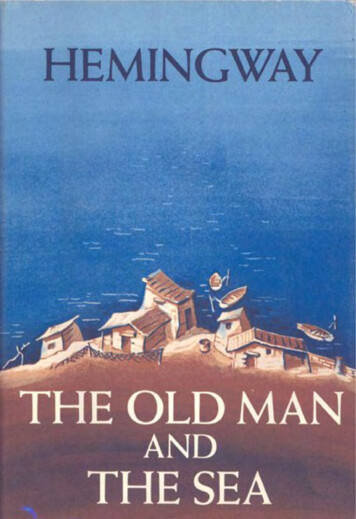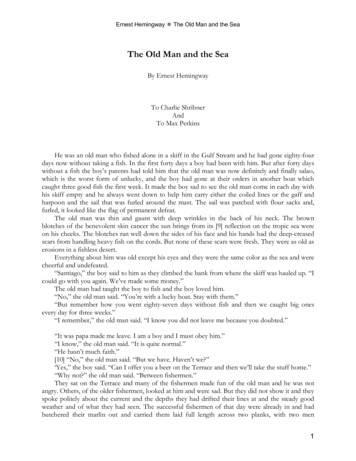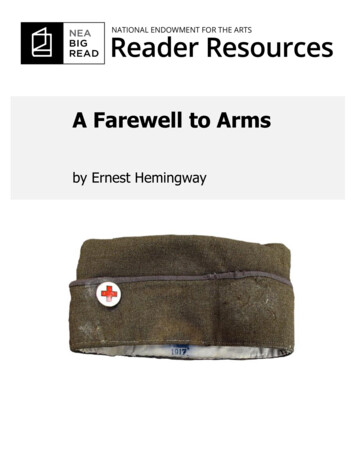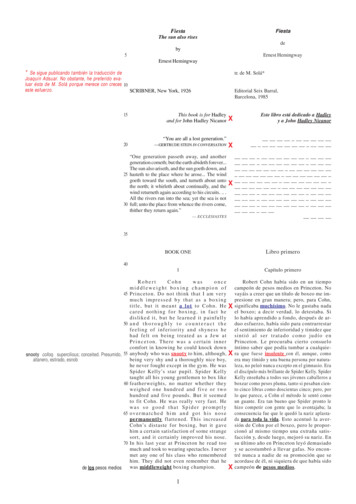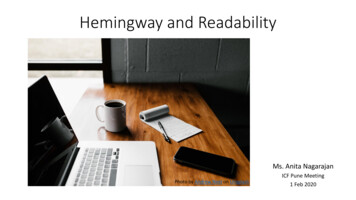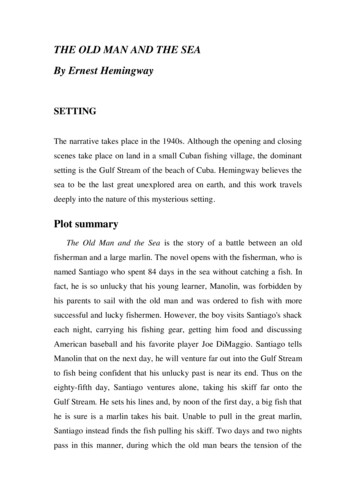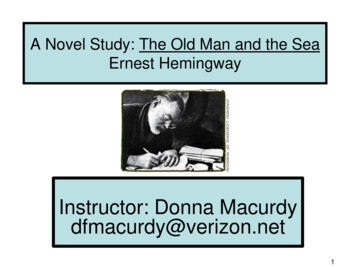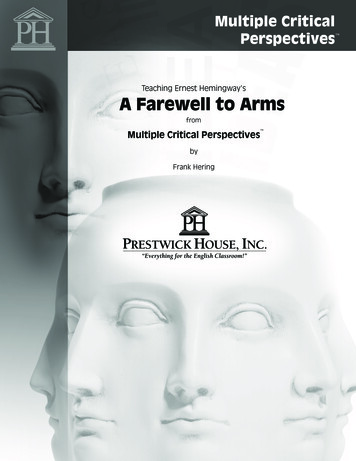
Transcription
SamplePrestwick HouseMultiple CriticalPerspectives Prestwick HouseTeaching Ernest Hemmingway’sA Farewell to ArmsfromMultiple Critical Perspectives Click hereto learn moreabout thisMultiple CriticalPerspectives! Click hereto find moreClassroom Resourcesfor this title! Prestwick HouseMore from Prestwick HouseLiteratureLiterary Touchstone ClassicsLiterature Teaching UnitsGrammar and WritingCollege and Career Readiness: WritingGrammar for WritingVocabularyVocabulary Power PlusVocabulary from Latin and Greek RootsReadingReading Informational TextsReading Literature
Multiple CriticalPerspectivesTeaching Ernest Hemingway'sA Farewell to ArmsfromMultiple Critical PerspectivesbyFrank Hering
Multiple CriticalPerspectivesA Farewell to ArmsOther titles in the Multiple Critical Perspective series include:A convenient order form is located in the back of this book.Picture of Dorian Gray, ThePride and PrejudiceRaisin in the Sun, ARichard IIIRomeo and JulietScarlet Letter, The Siddhartha Slaughterhouse-FiveTale of Two Cities, ATaming of the Shrew, TheTempest, The Things Fall ApartTo Kill a Mockingbird Twelfth Night Wuthering HeightsHeart of DarknessHouse on Mango Street, TheImportance of Being Earnest, TheInvisible Man (Ellison)Jane EyreKing LearLife of PiLord of the Flies Macbeth Metamorphosis, The Midsummer Night’s Dream, A Much Ado About Nothing Oedipus Rex Of Mice and Men Our Town1 984Animal FarmAnthem Awakening, The Brave New World Crucible, TheCry, The Beloved CountryDeath of a SalesmanDoll’s House, AEthan FromeFrankensteinGrapes of Wrath, The Great Expectations Great Gatsby, The HamletP.O. Box 658, Clayton, DE 19938www.prestwickhouse.com 800.932.4593ISBN 000-0-00000-000-0Copyright 2008 Prestwick House, Inc. All rights reserved.No portion may be reproduced without permission in writing from the publisher.2Pr e s t w i c kHo u s e,In c.
Multiple CriticalPerspectivesA Farewell to ArmsGeneral Introduction to the WorkHistorical FictionAFarewell to Arms is historical fiction, a story set in “the past,” that often involves historical eventseither directly in the plot or as a background to the main plot’s events. Historical novels may or maynot involve actual people who lived during the time period the story is set. Critics have not yet reachedan exact definition of historical fiction. The most popular opinions are that historical fiction is set in atime period either (1) before the author’s lifetime or (2) ten or more years before the time it was written.As Ernest Hemingway was born in 1899 and did, in fact, drive an ambulance for the Italian armyduring World War I. According to the first view of historical fiction, A Farewell to Arms is not a historicalnovel. According to the second view, it is. Clearly, however, the setting of World War I is more than meredecoration, and the characters’ attitudes and actions are shaped in large part by their context. Were thestory set in another time and against another background, the lives of the characters would inevitablyplay out differently. Thus, the novel can be considered “historical.”Set in Italy during the First World War, Hemingway’s novel revolves around Frederic Henry, anAmerican ambulance driver for the Italian Army. Seeking diversion from the war, Frederic enters into aromance with a British nurse also serving in Italy. The nurse, Catherine Barkley, has recently lost her longtime fiancé in one of the horrific battles of the Somme in France. Frederic and Catherine authenticallyrepresent many of the men and women who served with the Allied Forces in what contemporaries calledThe Great War; they not only faced difficult decisions about the importance of serving in the army andwinning the war, but they also experienced a growing love and began to worry about each other’s safetyand security.ModernismOver the twenty years before the Great War, confidence in traditional beliefs and expectationsgradually eroded under questions about the sanctity of religion, the efficacy of science, and the culturalisolationism of the U.S. Increasingly, change seemed necessary; the old needed to give way to the new. Asfamed critic and Hemingway biographer Michael S. Reynolds argues, “[t]he war merely put a period onthe end of a sentence that had been twenty years in the writing.” The artistic response to the feeling thatmodern life was more “disorganized” than had been expected is called modernism, which literary scholarsusually see as emerging between the two World Wars. Modernist writers and artists privileged dedicationto craft over traditional beliefs. Twentieth-century critic and social commentator Edmund Wilson recalledthat modernist writers wanted to create “something in which every word, every cadence, every detail,6Pr e s t w i c kHo u s e,In c.
A Farewell to ArmsMultiple CriticalPerspectivesActivity OneExamining key relationships and their relation to the structure of the novel1. Copy and distribute the handouts: A Farewell to Arms: Formalism Activity One Worksheets One,Two, and Three.2.Divide the class into three groups or a number of groups divisible by three.3.Assign each group one of the following relationships: Frederic and Rinaldi Frederic and the priest Catherine and FergusonNOTE: If you have more than three groups, you may assign more than one group to a relationship.4. Have each group peruse the novel for the places in which their assigned relationship makes asignificant appearance and complete the handout.5. As the groups examine their assigned relationships, have them discuss whether Hemingwayportrays each character and his or her interactions in his or her own right or merely as a literarydevice and note their findings on their handouts. Is each character in the relationship round or flat? complex or stereotypical? Does either character serve as a literary device (e.g., foil, antagonist, etc.)? Is either character used as a narrative device or vehicle (e.g., means of communicating expositionto the reader)? Is the relationship complex or simple? Does it change?Pr e s t w i c kHo u s e,In c.17
A Farewell to ArmsMultiple CriticalPerspectivesFeminist Theory Appliedto A Farewell to ArmsNotes on the Feminist TheoryFeminism is an evolving philosophy,and its application in literatureis a relatively new area of study. The basis of the movement, bothin literature and society, is that the Western world is fundamentallypatriarchal (i.e., created by men, ruled by men, viewed through the eyesof men, and judged by men).In the 1960s, the feminist movement began to form a newapproach to literary criticism. Of course, women had already been writingand publishing for centuries, but the 1960s saw the rise of a feministliterary theory. Until then, the works of female writers (or works aboutfemales) were examined by the same standards as those by male writers(and about men). Women were thought to be less intelligent than men,at least in part because they generally received less formal education,and many women accepted that judgment. It was not until the feministmovement was well under way that women began examining old texts,reevaluating the portrayal of women in literature, and writing new worksto fit the developing concept of the “modern woman.”The feminist approach is based on finding and exposing suggestionsof misogyny (negative attitudes toward women) in literature. Feministsare interested in exposing the undervaluing of women in literature thathas long been accepted as the norm by both men and women. Theyhave even dissected many words in Western languages that reflect apatriarchal worldview. Arguing that the past millennia in the Westhave been dominated by men—whether the politicians in power or thehistorians recording it all—feminist critics believe that Western literaturereflects a masculine bias, and, consequently, represents an inaccurate andpotentially harmful image of women. In order to repair this image andachieve balance, they insist that works by and about women be added tothe literary canon and read from a feminist perspective.Pr e s t w i c kHo u s e,In c.37
A Farewell to ArmsMultiple CriticalPerspectivesActivity OneExamining the key women in the novel1. Copy and distribute the handout: A Farewell to Arms: Feminism Activity One. You may want togive each student more than one copy of the sheet; then, she or he will be able to take notes duringthe group presentation as well.2. Divide the class into five groups or a number of groups divisible by five. Try to have male andfemale representation in every group.3.Assign each group (or allow each to choose) one of the following: Catherine in Books 1 – 2 Catherine in Book 3 – 4 Ferguson in Chapters V, XVII, XXXIV Miss Gage; Miss Van Campen in Chapters XIII, XVII, XXII Prostitutes in Chapters III, XVI4. Have each group complete “A Farewell to Arms Feminism Activity One Worksheet,” using a separateline for each character and each chapter.5.Reconvene the class and allow each group to report its findings and decisions to the class.6. As a whole class, discuss whether the women in A Farewell to Arms tend to be full-fledged characters,stereotypes, or literary conventions (such as foils).Pr e s t w i c kHo u s e,In c.41
A Farewell to ArmsMultiple CriticalPerspectivesMarxist Approach Appliedto A Farewell to ArmsNotes on the Marxist ApproachTheMarxist approach to literature is based on the philosophyof Karl Marx, a German philosopher and economist. His majorargument was that whoever controlled the means of production insociety controlled the society—whoever owned the factories “owned”the culture. This idea is called “dialectical materialism,” and Marx feltthat the history of the world was leading toward a communist society.From his point of view, the means of production (i.e., the basis ofpower in society) would be placed in the hands of the masses, whoactually operated them, not in the hands of those few who ownedthem. It was a perverted version of this philosophy that was at theheart of the Soviet Union. Marxism was also the rallying cry of thepoor and oppressed all over the world.To read a work from a Marxist perspective, one must understandthat Marxism asserts that literature is a reflection of culture, and thatculture can be affected by literature (Marxists believed literature couldinstigate revolution). Marxism is linked to Freudian theory by itsconcentration on the subconscious—Freud dealt with the individualsubconscious, while Marx dealt with the political subconscious.Marx believed that oppression exists in the political subconscious ofa society—social pecking orders are inherent to any group of people.Four main areas of study: economic power materialism versus spirituality class conflict art, literature, and ideologiesPr e s t w i c kHo u s e,In c.51
A Farewell to ArmsMultiple CriticalPerspectivesActivity OneExamining the novel for evidence of class conflict and struggle1. Copy and distribute the handouts: A Farewell to Arms: Marxism Activity One Worksheet and AFarewell to Arms: Marxism Activity One Worksheet Two.2.Divide the class into five groups or a number of groups divisible by five.3.Assign each group (or allow each to choose) one of the following incidents: The mechanics’ interactions with Frederic before their trench is hit in Chapter IX Frederic’s discussion with the priest in Chapter XI Frederic’s discussion with the British major in the first paragraph of Chapter XXI Rinaldi’s behavior when Frederic returns in Chapter XXV The retreat from Caporetto in Chapter XXIX and the escape at the Tagliamento River in ChaptersXXXI and XXXII.4. Have each group re-read its assigned section(s) of the novel and complete Worksheet Two, followingthe example provided in Worksheet One.5.Reconvene the class and allow each group to report its findings.6. As a whole class, discuss whether Hemingway appears to take one side or another in the classconflicts in his novel, or does he seem to remain neutral in his presentation of class differences?Pr e s t w i c kHo u s e,In c.55
6 P r e s t w i c k H o u s e, i n c. Multiple Critical Perspectives A Farewell to Arms General Introduction to the Work Historical Fiction A Farewell to arms is historical fiction, a story set in "the past," that often involves historical events either directly in the plot or as a background to the main plot's events.
